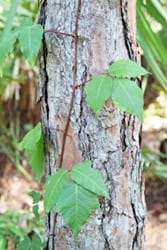
In the winter, dormant poison ivy and oak plants may lose all their leaves and berries, and it can be difficult to tell if the plants are still alive. Even with dead poison ivy, all parts of the plants, including the roots and stems, contain rash-causing urushiol. A tiny amount of urushiol can turn into a full-blown reaction to those who are sensitive to the plants, and it will remain intact and does not evaporate after the plants die.
Strategies to handle and remove these plants include ideas like wearing disposable gloves, covering the plant with a plastic bag before you pull it out of the ground, or using heavy-duty weed-killing poisons. No matter what you decide to use to remove a poison ivy plant (including dead plants), you should follow up by cleansing any skin, clothing, tools, or equipment that may have been in contact with the plant to remove urushiol. Tecnu Original Outdoor Skin Cleanser can be used on any of these items to remove the rash-causing oil. Tecnu Extreme Poison Ivy Scrub is also an excellent body wash that can be stored in the shower for a superior cleansing to remove the rash-causing oil.
Be careful handling firewood in the winter!
A common way of getting poison ivy in the winter is by handling firewood. Be cautious of any cut trees that have leafless vines wrapped around them as you could touch dead poison ivy without realizing it. Burning poison ivy or oak can be quite dangerous as it can result in inhalation of urushiol causing a severe rash that spreads systemically throughout the body.




